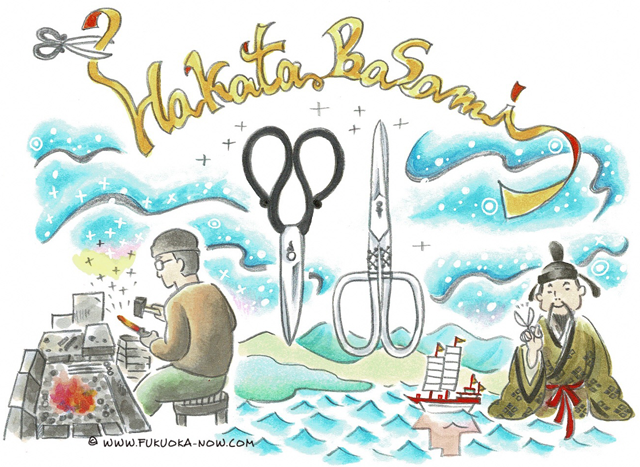Hakata Culture vol.144
Hakata Hasami: Scissors as Sharp as a Samurai Sword

Hakata hasami (scissors), a local handicraft, can last a lifetime if cared for properly, and their sharpness is comparable to that of a samurai sword! Only highly skilled artisans can make the scissors, which are typified by a distinctive double-X pattern on the handle. Between 1935 and 1945, the scissors were so popular throughout Japan that the word hasami itself was assumed to mean Hakata hasami scissors. Even today, they remain popular among dressmakers.
Hakata hasami date back to around 700 years ago when a merchant named Mei Shakoku, who relocated here from the Southern Song dynasty of China, bought scissors with him. This is why, for a long time, they were referred to as tobasami (because it is the character that refers to the old name for China). The trademark sharpness comes from the fact swordsmiths initially forged the scissors, so many swordmaking techniques were incorporated into their production. What’s more, the scissors used to be presented as gifts to the Shogunate.
At the end of the Edo period, a swordsmith named Usuke Yasukochi, based in what is now Reisen-machi (Hakata Ward), achieved a design that has remained more or less unchanged to the present day. Upon entering the Meiji era, Yasukochi took on a protégé named Kamekichi Takayanagi, who would later inherit the double-X mark, the sign of a master craftsman, and strike out on his own in 1887. Not long after this, he changed the name tobasami to Hakata hasami, and the scissors became well-known throughout Japan.
Records indicate that there were nearly 20 scissor makers in and around Reisen-machi before World War II, but now only one, the third-generation craftsman, Seiichi Takayanagi, remains. Almost all of his scissors are made to order, and it can take between six months and one year for him to complete an order. Some of his scissors are on display at Hakata Traditional Craft Center, and Hakata Machiya Folk Museum and are available for sale, so you can try them for yourself to see just how sharp they are.
日本刀のような切れ味の博多鋏(はさみ)
手入れを欠かさず大切に使えば、一生使うことができるという博多鋏。その切れ味は日本刀にもたとえられるほどで、切れ味抜群です。熟練した職人だけがつくり出せる銀色の優美な姿に、持ち手の部分に菱形の文様が刻まれているのが大きな特徴。昭和10年代(1935~45年)には、ハサミといえば博多鋏のことを指すと言われるほど全国的に有名でした。現在でも洋裁をする人には人気があります。
博多鋏は今から約700年前、南宋から博多に移り住んだ貿易商人・謝国明(しゃこくめい)が、中国から持ち込んだ鋏がルーツとされています。そのため長く「唐鋏」(唐=中国のこと)と呼ばれていました。実際に日本刀を手がける刀鍛冶師によってつくられていたため、刀に由来する製法が多く取り入れられ、鋭い切れ味の秘密もそこにあります。かつては幕府への献上品でもありました。
幕末の頃、博多箔屋番(現在の博多区冷泉町)に住む刀鍛冶師の安河内卯助が、現在の形に近い鋏を完成させます。明治時代に入り、この卯助の弟子となるのが高柳亀吉です。亀吉はやがて師匠の刻印である「宇印」を受け継いで、明治20年(1887年)に独立します。独立後に唐鋏を博多鋏と改称して売り出したことから、広く博多鋏の名が知られるようになりました。
戦前には冷泉町付近に約20軒の鋏鍛冶がいたという記録が残っていますが、現在では高柳家の三代目・高柳晴一さんだけが博多鋏をつくり続けています。基本的にオーダーメイドで製作するため、注文してから手元に届くまで半年から1年かかるとされています。「はかた伝統工芸館」や「博多町家ふるさと館」などで展示販売されていることもあるので、見つけたらぜひ手に取って、その切れ味を確かめてみてください。

